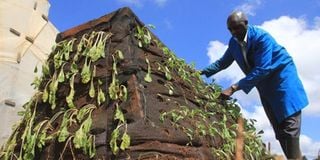Forget the sack, here is the new garden in town

Mr John Wambugu, an agronomist at Wambugu Agricultural Training Centre in Nyeri plants 'Sukuma wiki' seedlings on a Linear Multi Storey garden on May 15, 2014. Photo | JOSEPH KANYI
What you need to know:
- The agronomist notes that similar garden technology has been used to grow green leafy vegetables, tomatoes, cabbages, carrots, tubers and indigenous vegetables.
- The contribution of urban farming to food security and nutrition is critical. The government and its partners have pushed for the growth of vegetables using sack gardens.
As land shrinks in urban areas, many families are finding it difficult to have kitchen gardens, where they can grow vegetables and other crops for subsistence.
They, therefore, rely on food from grocery stores, some of which is costly.
But researchers are working on new technologies to encourage urban dwellers to engage in farming to boost food security.
John Wambugu is among the researchers and has come up with what one may call a perfect urban garden.
The garden, which he has christened Linear Multi-Storey Garden (LMSG), can be used to grow vegetables, tomatoes, capsicum and even maize.
“The garden is made up of timber, binding wires and old mosquito nets. The amount of the materials used depends on the size of LSMG one wants,” explains Wambugu, an agronomist.
The garden has about half-a-metre vertical columns made up of polythene papers with stones placed in the middle.
The columns are used to feed the crops with water and are placed at a distance of a metre apart. “While making the columns, one should make sure that soil doesn’t enter in them but only stones to create air spaces.
Wambugu says he came up with the garden to help those living in urban areas to grow vegetables and spices, thus reduce the cost of buying food as well as fight food insecurity.
The garden is shaped like a pyramid to allow slow and smooth flow of water downwards as well as create more space for growing vegetables.
The LSMG can be used in urban areas just like the sack garden reputed for utilising minimal space and water, but it is also suitable for regions dependent on livestock and in semi-arid lands.
“The development and adaptation of LSMG will address food insecurity. And if Kenyans living in urban areas can utilise the small spaces they have with such a technology, the cost of expenditure will be minimised,” says the researcher who works at the government’s Wambugu Agricultural Training Centre in Nyeri.
To make the garden, one has to have a mound of fertile soil, where the plants would grow.
“You begin by constructing the structure that would hold the soil using timber. Then you put in columns and pebbles. Thereafter, you put in the soil and wound around the mosquito net,” explains Wambugu of the technology currently being used in Nyeri by about 10 farmers.
“The mosquito net is used to hold the soil with the support of binding wires, which are nailed firmly on the pyramid-shaped timbers.”
His technology requires little technical and financial support. “Small holes are made on the mosquito net where one will plant crops. Depending on the size of LSMG one has, one can plant as many crops as the space allows them.”
Wambugu is optimistic that come next month when the centre will be training farmers, he will be able to sell the idea to many people.
The contribution of urban farming to food security and nutrition is critical. The government and its partners have pushed for the growth of vegetables using sack gardens.
Multi-storey gardening, according to Wambugu, is an exciting technology for anyone who wants to grow vegetable all-year round.
After one plants crops, just like other gardens, watering and removing of weeds is essential and this can be done manually by one person.
The agronomist notes that similar garden technology has been used to grow green leafy vegetables, tomatoes, cabbages, carrots, tubers and indigenous vegetables.
The technology, according to him, can be used in schools to provide vegetables and teach science and nutrition.
It is also a good income-generating venture for people who own groceries and who want to engage in agribusiness.
“By using old mosquito nets, I am playing a big role in cleaning the environment by recycling the equipment.”
To have a good harvest, he says one needs to use manure.
“You mix manure with water and pour in the column twice a day for one week so that it spreads in the soil before planting any crop. This is to allow the manure to decompose and the nutrients to mix properly with the soil.”
Harvesting should be done two to three times a week after the vegetables mature.
Alex Wanjohi, a farmer who has adopted the new technology, says he is eagerly waiting to harvest.
“The crops have done well. I am even hopeful that I will start selling the surplus to the nearby groceries in Skuta estate, Nyeri.”




